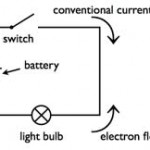Introduction To Electric Circuit Analysis
INTRODUCTION TO ELECTRIC CIRCUIT ANALYS
ELECTRIC CIRCUIT:
It is a path in which electrons flow from a voltage or current source in a closed path. This closed path is known as an electrical circuit.
ELECTRIC CURRENT:
The rate of flow of electric charge through any cross section of the conductor is known as electric current.
Electric current are of following four types:
a) Direct current or steady current:
It is the current whose magnitude as well as direction remains constant at all times.
b) Varying current:
It is the current whose magnitude varies with respect to time but direction remains unchanged.
c) Transient current:
It is the current for a very short interval of time.
d) Alternating current:
It is the current whose magnitude changes continuously and direction changes at regular intervals of time.
CURRENT DENSITY:
Current density is defined as the current per unit cross sectional area as a vector quantity. It is denoted as J’ and the expression is:
J’=(I/A), where J’ is the current density, I is the current and A is the cross sectional area.
VOLTAGE SOURCES:
An ideal voltage source is a circuit where the voltage across it is independent of the current. In an electric circuit analysis a voltage source supplies a constant DC or AC potential across its terminals for any current flow through it.
A voltage source is of two types:-
a) Ideal voltage source:
A voltage source that maintains constant terminal voltage , irrespective of variations in load current is called an ideal voltage source.
b) Practical voltage source:
A voltage source in which the internal resistance is not zero is treated as a practical voltage source.
CURRENT SOURCES:
It is an electronic circuit which is independent of the voltage across it. It is the dual of a voltage source.
It is of two types:
a) Ideal current source:
A current source that maintains constant output current irrespective of variations in load is called an ideal current source.
b) Practical current source:
A current source in which the internal resistance has a finite value,is treated as a practical current source .
VOLTAGE SOURCE vs CURRENT SOURCE:
1) All the sources of electrical energy are considered as voltage sources while a current source gives a constant current till the load connected to the source terminals has sufficiently low impedance.
2) An ideal voltage source is loaded by an open circuit,it provides no energy but approaches infinite energy while an ideal current approaches infinite energy and provides no energy to a short circuit.
3) As no ideal sources exist any current source is considered as voltage with impedance and vice versa.
EXPECTED QUESTIONS WITH ANSWERS:
1) What is an electrical circuit?
Ans: A path in which electrons flow from a voltage or current source in a closed path. This closed path is known as an electrical circuit.
2) What is an electric current and its types?
Ans: The rate of flow of electric charge through any cross section of the conductor is known as electric current.
Electric current are of following four types:
a) Direct current or steady current:
It is the current whose magnitude as well as direction remains constant at all times.
b) Varying current:
It is the current whose magnitude varies with respect to time but direction remains unchanged.
c) Transient current:
It is the current for a very short interval of time.
d) Alternating current:
It is the current whose magnitude changes continuously and direction changes at regular intervals of time.
3) What is a voltage source and what are its types?
Ans: An ideal voltage source is a circuit where the voltage across it is independent of the current. In an electric circuit analysis a voltage source supplies a constant DC or AC potential across its terminals for any current flow through it.
A voltage source is of two types:-
a) Ideal voltage source:
A voltage source that maintains constant terminal voltage , irrespective of variations in load current is called an ideal voltage source.
b) Practical voltage source:
A voltage source in which the internal resistance is not zero is treated as a practical voltage source.
4) What is a current source and what are its types?
Ans: It is an electronic circuit which is independent of the voltage across it. It is the dual of a voltage source.
It is of two types:
a) Ideal current source:
A current source that maintains constant output current irrespective of variations in load is called an ideal current source.
b) Practical current source:
A current source in which the internal resistance has a finite value,is treated as a practical current source .
5) What are the differences between voltage source and current source?
Ans: a) All the sources of electrical energy are considered as voltage sources while a current source gives a constant current till the load connected to the source terminals has sufficiently low impedance.
b) An ideal voltage source is loaded by an open circuit,it provides no energy but approaches infinite energy while an ideal current approaches infinite energy and provides no energy to a short circuit.
c) As no ideal sources exist any current source is considered as voltage with impedance and vice versa.
GATE Syllabus-
1. Gate Syllabus for Electrical Engineering 2014
IES Syllabus-
1. IES Syllabus for General ability
« Signal Degradation In Optical Fiber Static And Dynamic Response »





Tell us Your Queries, Suggestions and Feedback